Trends and Obstacles to Implement Dynamic Perfusion Concepts for Clinical Liver Transplantation: Results from a Global Web-Based Survey
Abstract
1. Introduction
2. Materials and Methods
2.1. Study Design
2.2. Study Target
2.3. Data Collection
2.4. Data Analysis
3. Results
3.1. Demographical Data
3.2. What Are the Experience and Current Clinical Applications of Perfusion Technology?
3.3. What Is the Role of Perfusion Technology in the Utilization of Marginal Organs?
3.4. What Are the Current Challenges in Implementing Perfusion Technology in Routine Clinical Practice?
3.5. What Is an Acceptable Price for Organ Perfusion Technology?
4. Discussion
Supplementary Materials
Author Contributions
Funding
Institutional Review Board Statement
Informed Consent Statement
Data Availability Statement
Acknowledgments
Conflicts of Interest
References
- Nasralla, D.; for the Consortium for Organ Preservation in Europe; Coussios, C.C.; Mergental, H.; Akhtar, M.Z.; Butler, A.J.; Ceresa, C.D.L.; Chiocchia, V.; Dutton, S.J.; García-Valdecasas, J.C.; et al. A randomized trial of normothermic preservation in liver transplantation. Nature 2018, 557, 50–56. [Google Scholar] [CrossRef]
- van Rijn, R.; Schurink, I.J.; de Vries, Y.; van den Berg, A.P.; Cortes Cerisuelo, M.; Darwish Murad, S.; Erdmann, J.I.; Gilbo, N.; de Haas, R.J.; Heaton, N.; et al. Hypothermic Machine Perfusion in Liver Transplantation—A Randomized Trial. N. Engl. J. Med. 2021, 384, 1391–1401. [Google Scholar] [CrossRef]
- Czigany, Z.; Pratschke, J.; Froněk, J.; Guba, M.; Schöning, W.; Raptis, D.A.; Andrassy, J.; Kramer, M.; Strnad, P.; Tolba, R.H.; et al. Hypothermic Oxygenated Machine Perfusion Reduces Early Allograft Injury and Improves Post-transplant Outcomes in Extended Criteria Donation Liver Transplantation from Donation after Brain Death: Results from a Multicenter Randomized Controlled Trial (HOPE ECD-DBD). Ann. Surg. 2021, 274, 705–712. [Google Scholar]
- Ravaioli, M.; Germinario, G.; Dajti, G.; Sessa, M.; Vasuri, F.; Siniscalchi, A.; Morelli, M.C.; Serenari, M.; Del Gaudio, M.; Zanfi, C.; et al. Hypothermic oxygenated perfusion in extended criteria donor liver transplantation—A randomized clinical trial. Am. J. Transplant. 2022, 7, 2401–2408. [Google Scholar] [CrossRef] [PubMed]
- Markmann, J.F.; Abouljoud, M.S.; Ghobrial, R.M.; Bhati, C.S.; Pelletier, S.J.; Lu, A.D.; Ottmann, S.; Klair, T.; Eymard, C.; Roll, G.R.; et al. Impact of Portable Normothermic Blood-Based Machine Perfusion on Outcomes of Liver Transplant: The OCS Liver PROTECT Randomized Clinical Trial. JAMA Surg. 2022, 157, 189–198. [Google Scholar] [CrossRef] [PubMed]
- Jochmans, I.; Brat, A.; Davies, L.; Hofker, H.S.; van de Leemkolk, F.E.M.; Leuvenink, H.G.D.; Knight, S.R.; Pirenne, J.; Ploeg, R.J. COMPARE Trial Collaboration and Consortium for Organ Preservation in Europe (COPE). Oxygenated versus standard cold perfusion preservation in kidney transplantation (COMPARE): A randomized, double-blind, paired, phase 3 trial. Lancet 2020, 396, 1653–1662. [Google Scholar] [CrossRef] [PubMed]
- Hessheimer, A.J.; de la Rosa, G.; Gastaca, M.; Ruíz, P.; Otero, A.; Gómez, M.; Alconchel, F.; Ramírez, P.; Bosca, A.; López-Andújar, R.; et al. Abdominal normothermic regional perfusion in controlled donation after circulatory determination of death liver transplantation: Outcomes and risk factors for graft loss. Am. J. Transplant. 2022, 22, 1169–1181. [Google Scholar] [CrossRef]
- Guarrera, J.V.; Henry, S.D.; Samstein, B.; Odeh-Ramadan, R.; Kinkhabwala, M.; Goldstein, M.J.; Ratner, L.E.; Renz, J.F.; Lee, H.T.; Brown, R.; et al. Hypothermic machine preservation in human liver transplantation: The first clinical series. Am. J. Transplant. 2010, 10, 372–381. [Google Scholar] [CrossRef]
- Mergental, H.; Laing, R.W.; Kirkham, A.J.; Perera, M.T.P.R.; Boteon, Y.L.; Attard, J.; Barton, D.; Curbishley, S.; Wilkhu, M.; Neil, D.A.H.; et al. Transplantation of discarded livers following viability testing with normothermic machine perfusion. Nat. Commun. 2020, 11, 2939. [Google Scholar] [CrossRef]
- Gaurav, R.; Butler, A.J.; Kosmoliaptsis, V.; Mumford, L.; Fear, C.; Swift, L.; Fedotovs, A.; Upponi, S.; Khwaja, S.; Richards, J.; et al. Liver Transplantation Outcomes from Controlled Circulatory Death Donors: SCS vs in situ NRP vs ex situ NMP. Ann. Surg. 2022, 275, 1156–1164. [Google Scholar] [CrossRef]
- Widmer, J.; Eden, J.; Carvalho, M.F.; Dutkowski, P.; Schlegel, A. Machine Perfusion for Extended Criteria Donor Livers: What Challenges Remain? J. Clin. Med. 2022, 11, 5218. [Google Scholar] [CrossRef] [PubMed]
- Marcon, F.; Schlegel, A.; Bartlett, D.C.; Kalisvaart, M.; Bishop, D.; Mergental, H.; Roberts, K.J.; Mirza, D.F.; Isaac, J.; Muiesan, P.; et al. Utilization of Declined Liver Grafts Yields Comparable Transplant Outcomes and Previous Decline Should Not Be a Deterrent to Graft Use. Transplantation 2018, 102, e211–e218. [Google Scholar] [CrossRef]
- Schlegel, A. Machine Perfusion as “Comfort Zone”: What Are Key Challenges of Liver Viability Assessment Today? Transplantation 2022, 106, 2295–2298. [Google Scholar] [CrossRef]
- De Carlis, R.; Lauterio, A.; Centonze, L.; Buscemi, V.; Schlegel, A.; Muiesan, P.; De Carlis, L.; Carraro, A.; Ghinolfi, D.; De Simone, P.; et al. Current practice of normothermic regional perfusion and machine perfusion in donation after circulatory death liver transplants in Italy. Updates Surg. 2022, 74, 501–510. [Google Scholar] [CrossRef]
- Schlegel, A.; van Reeven, M.; Croome, K.; Parente, A.; Dolcet, A.; Widmer, J.; Meurisse, N.; De Carlis, R.; Hessheimer, A.; Jochmans, I.; et al. A multicentre outcome analysis to define global benchmarks for donation after circulatory death liver transplantation. J. Hepatol. 2022, 76, 371–382. [Google Scholar] [CrossRef] [PubMed]
- Antoine, C.; Jasseron, C.; Dondero, F.; Savier, E.; French National Steering Committee of Donors after Circulatory Death. Liver Transplantation from Controlled Donors after Circulatory Death Using Normothermic Regional Perfusion: An Initial French Experience. Liver Transpl. 2020, 26, 1516–1521. [Google Scholar] [CrossRef] [PubMed]
- Watson, C.J.; Hunt, F.; Messer, S.; Currie, I.; Large, S.; Sutherland, A.; Crick, K.; Wigmore, S.J.; Fear, C.; Cornateanu, S.; et al. In situ normothermic perfusion of livers in controlled circulatory death donation may prevent ischemic cholangiopathy and improve graft survival. Am. J. Transplant. 2019, 19, 1745–1758. [Google Scholar] [CrossRef]
- Schlottmann, F.; Gerber, D.A.; Patti, M.G. International medical graduates and unfilled positions in abdominal transplant surgery fellowships in the United States. Transplant. Int. 2018, 31, 566. [Google Scholar] [CrossRef]
- Kaldas, F.M.; Rocca, J.P.; Bhati, C.S.; Duan, N.; Evenson, A.R.; Tan, H.P.; Redfield, R.R.; Di Sabato, D.M.; Yoshida, A.; Abt, P.L.; et al. The abdominal transplant surgery workforce: Current state and future trends. Clin. Transplant. 2019, 33, e13659. [Google Scholar] [CrossRef]
- Patrono, D.; De Stefano, N.; Martins, P.N.; Romagnoli, R.; Meeting Collaborators. Highlights from the Turin international workshop on liver machine perfusion. Artif. Organs 2022, 46, 2511–2517. [Google Scholar] [CrossRef]
- Zimmermann, J.; Carter, A.W. Cost-utility analysis of normothermic and hypothermic ex-situ machine perfusion in liver transplantation. Br. J. Surg. 2022, 109, e31–e32. [Google Scholar] [CrossRef] [PubMed]
- Boteon, Y.L.; Hessheimer, A.J.; Brüggenwirth, I.M.A.; Boteon, A.P.C.S.; Padilla, M.; de Meijer, V.E.; Domínguez-Gil, B.; Porte, R.J.; Perera, M.T.P.R.; Martins, P.N. The economic impact of machine perfusion technology in liver transplantation. Artif. Organs 2022, 46, 191–200. [Google Scholar] [CrossRef] [PubMed]
- Baboolal, K.; McEwan, P.; Sondhi, S.; Spiewanowski, P.; Wechowski, J.; Wilson, K. The cost of renal dialysis in a UK setting—A multicentre study. Nephrol. Dial. Transplant. 2008, 23, 1982–1989. [Google Scholar] [CrossRef] [PubMed]
- Ferguson, T.W.; Harper, G.D.; Milad, J.E.; Komenda, P.V.J. Cost of the quanta SC+ hemodialysis system for self-care in the United Kingdom. Hemodial. Int. 2022, 26, 287–294. [Google Scholar] [CrossRef]
- Kaplan, J.M.; Niu, J.; Ho, V.; Winkelmayer, W.C.; Erickson, K.F. A Comparison of US Medicare Expenditures for Hemodialysis and Peritoneal Dialysis. J. Am. Soc. Nephrol. 2022, 18, ASN.2022020221. [Google Scholar] [CrossRef]
- Eriksson, J.K.; Neovius, M.; Jacobson, S.H.; Elinder, C.G.; Hylander, B. Healthcare costs in chronic kidney disease and renal replacement therapy: A population-based cohort study in Sweden. BMJ Open 2016, 6, e012062. [Google Scholar] [CrossRef]
- Wenzl, M.; Mossialos, E. Prices for Cardiac Implant Devices May Be up to Six Times Higher in the US Than in Some European Countries. Health Aff. 2018, 37, 1570–1577. [Google Scholar] [CrossRef]
- Jay, C.L.; Lyuksemburg, V.; Kang, R.; Preczewski, L.; Stroupe, K.; Holl, J.L.; Abecassis, M.M.; Skaro, A.I. The increased costs of donation after cardiac death liver transplantation: Caveat emptor. Ann. Surg. 2010, 251, 743–748. [Google Scholar] [CrossRef]
- Groen, H.; Moers, C.; Smits, J.M.; Treckmann, J.; Monbaliu, D.; Rahmel, A.; Paul, A.; Pirenne, J.; Ploeg, R.J.; Buskens, E. Cost-effectiveness of hypothermic machine preservation versus static cold storage in renal transplantation. Am. J. Transplant. 2012, 12, 1824–1830. [Google Scholar] [CrossRef]
- Rayar, M.; Beaurepaire, J.; Bajeux, E.; Hamonic, S.; Renard, T.; Locher, C.; Desfourneaux, V.; Merdrignac, A.; Bergeat, D.; Lakehal, M.; et al. Hypothermic oxygenated perfusion improves extended criteria donor liver graft function and reduces duration of hospitalization without extra cost: The PERPHO study. Liver Transpl. 2021, 27, 349–362. [Google Scholar] [CrossRef]
- Patrono, D.; Cussa, D.; Rigo, F.; Romagnoli, R.; Liver Machine Perfusion Survey Group. Heterogeneous indications and the need for viability assessment: An international survey on the use of machine perfusion in liver transplantation. Artif. Organs 2022, 46, 296–305. [Google Scholar] [CrossRef] [PubMed]
- Flores Carvalho, M.; Boteon, Y.L.; Guarrera, J.V.; Modi, P.R.; Lladó, L.; Lurje, G.; Kasahara, M.; Dutkowski, P.; Schlegel, A. Obstacles to implement machine perfusion technology in routine clinical practice of transplantation—Why are we not there yet? Hepatology 2023, in press. [Google Scholar] [CrossRef] [PubMed]
- Quintini, C.; Martins, P.N.; Shah, S.; Killackey, M.; Reed, A.; Guarrera, J.; Axelrod, D.A.; American Society of Transplant Surgeons Standards Committee. Implementing an innovated preservation technology: The American Society of Transplant Surgeons’ (ASTS) Standards Committee White Paper on Ex Situ Liver Machine Perfusion. Am. J. Transplant. 2018, 18, 1865–1874. [Google Scholar] [CrossRef] [PubMed]
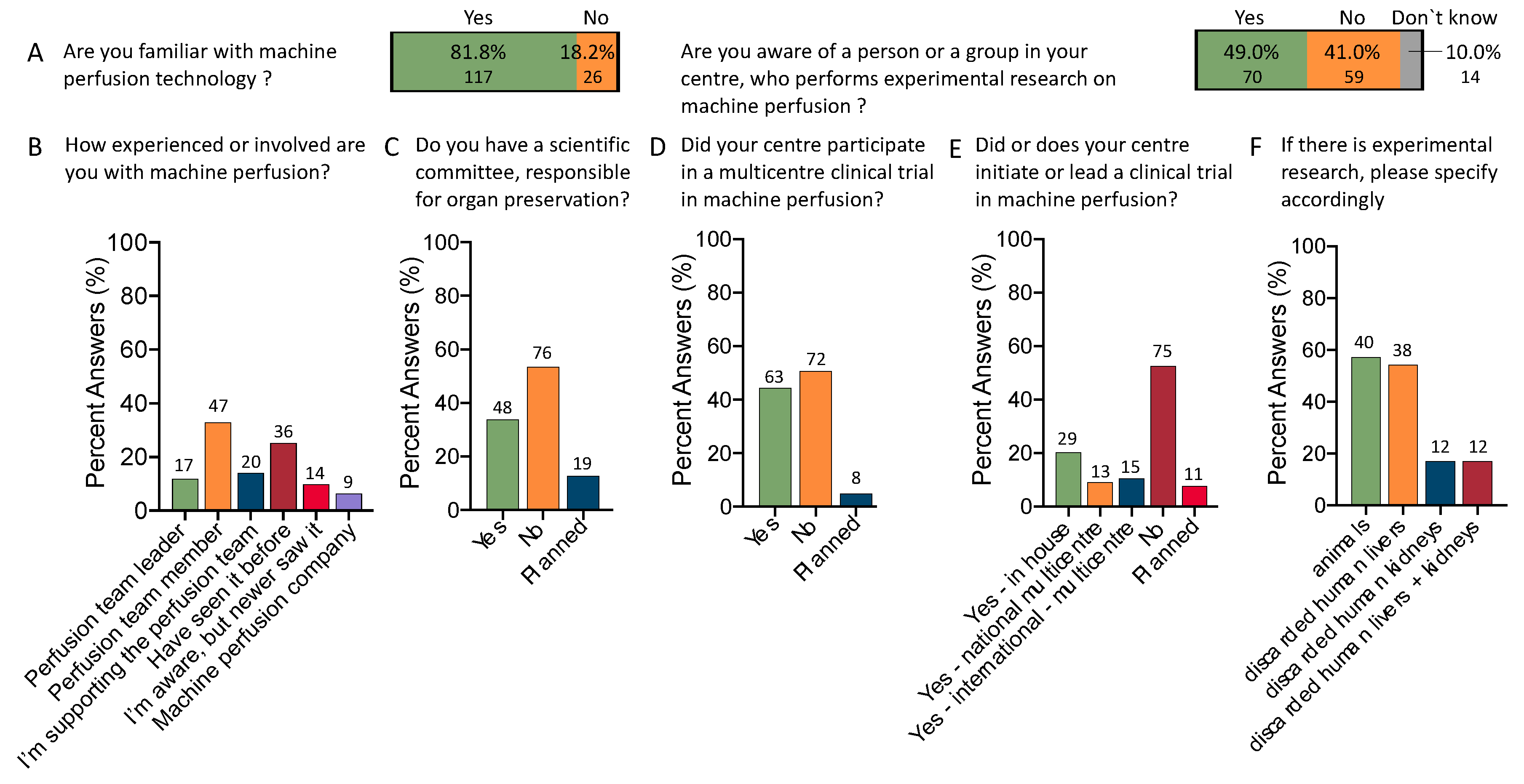

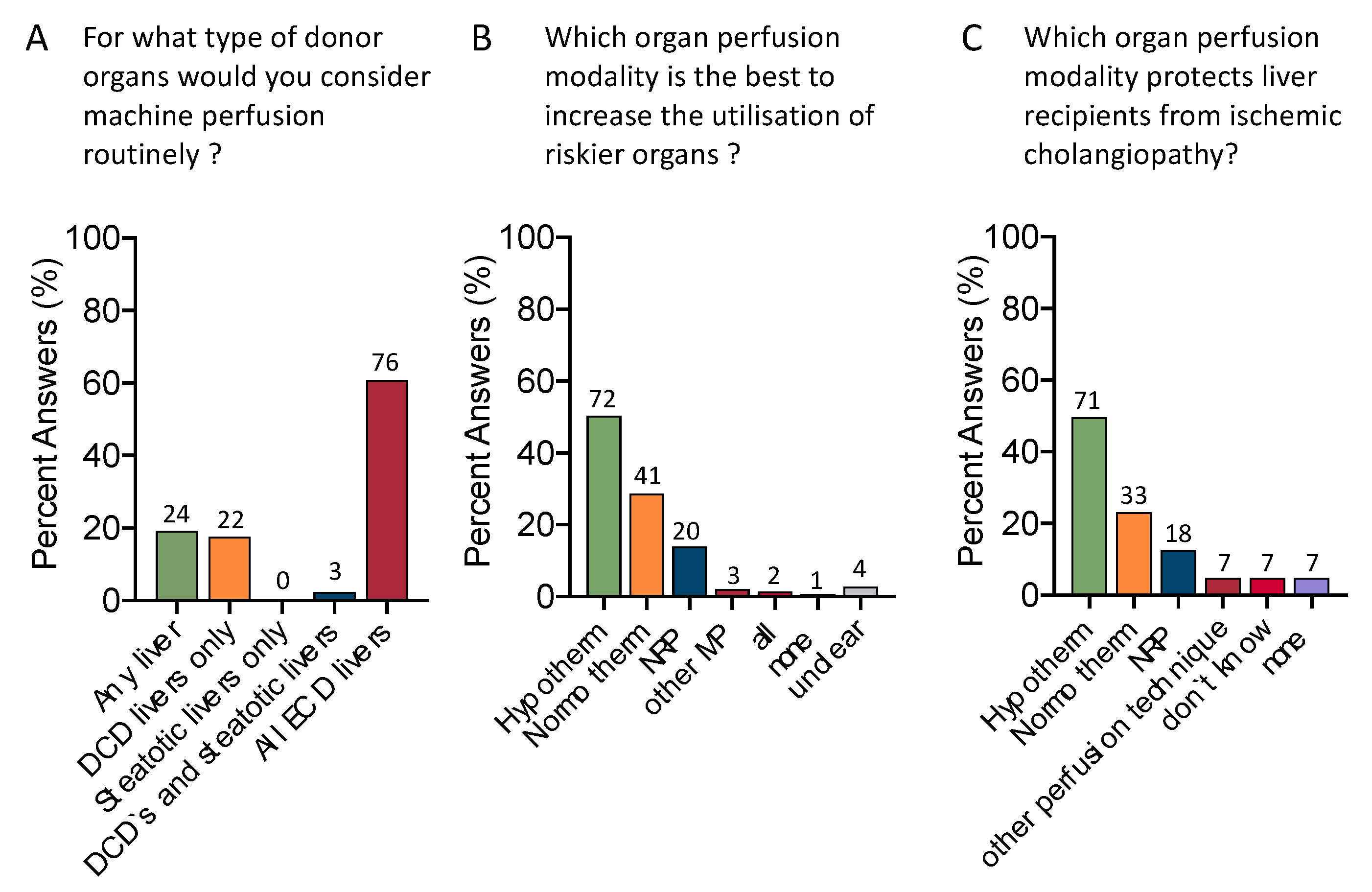
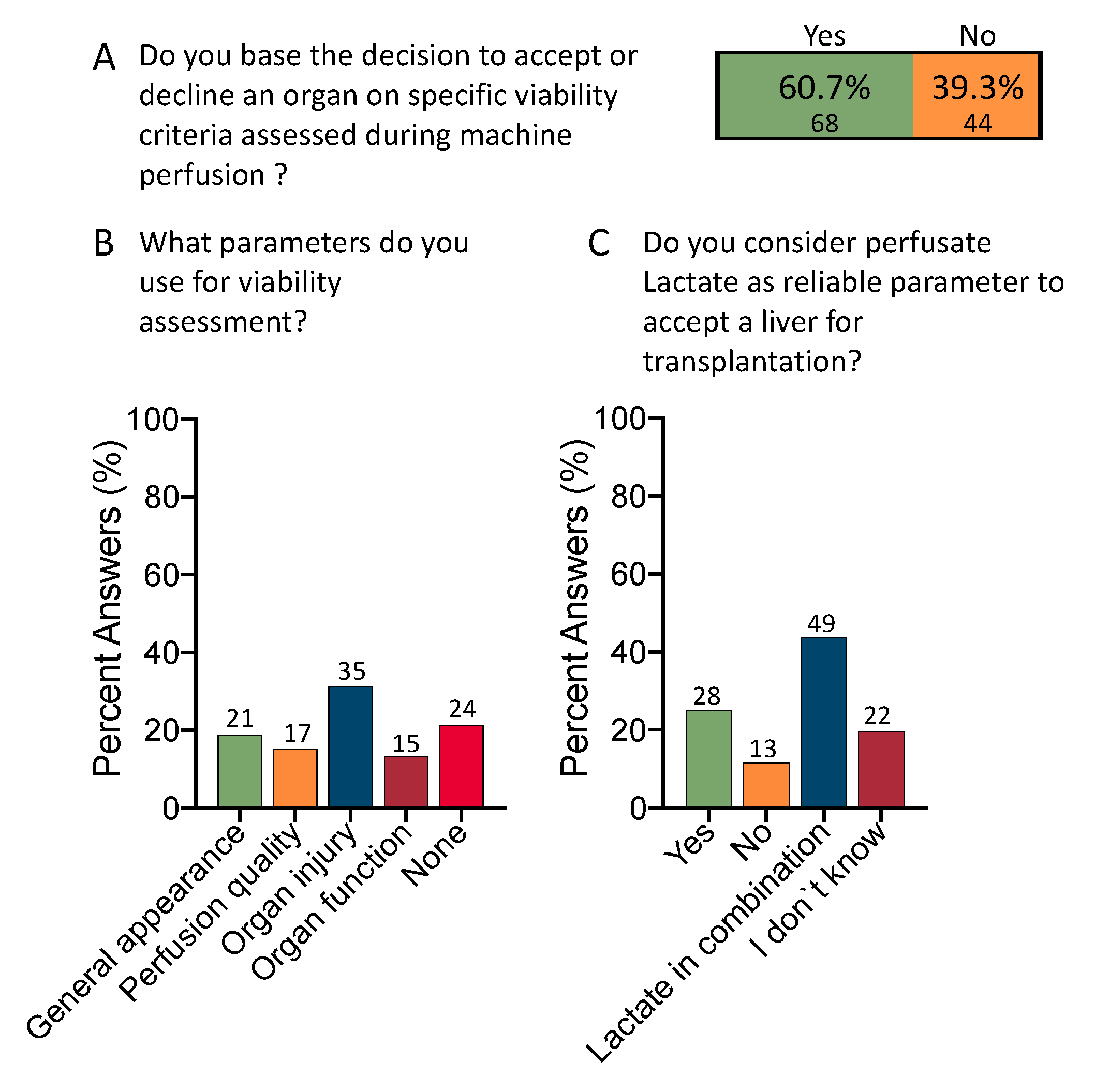
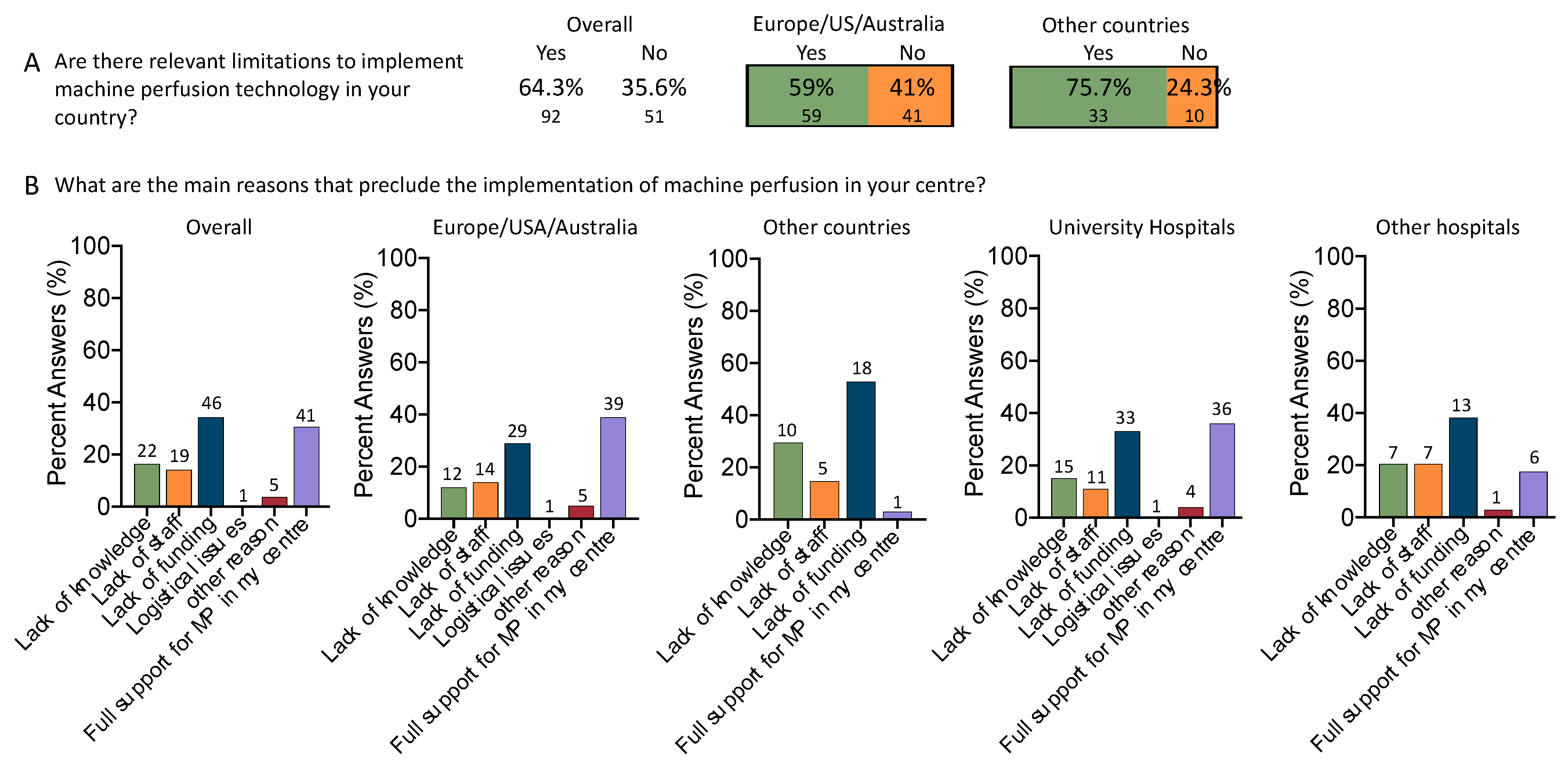
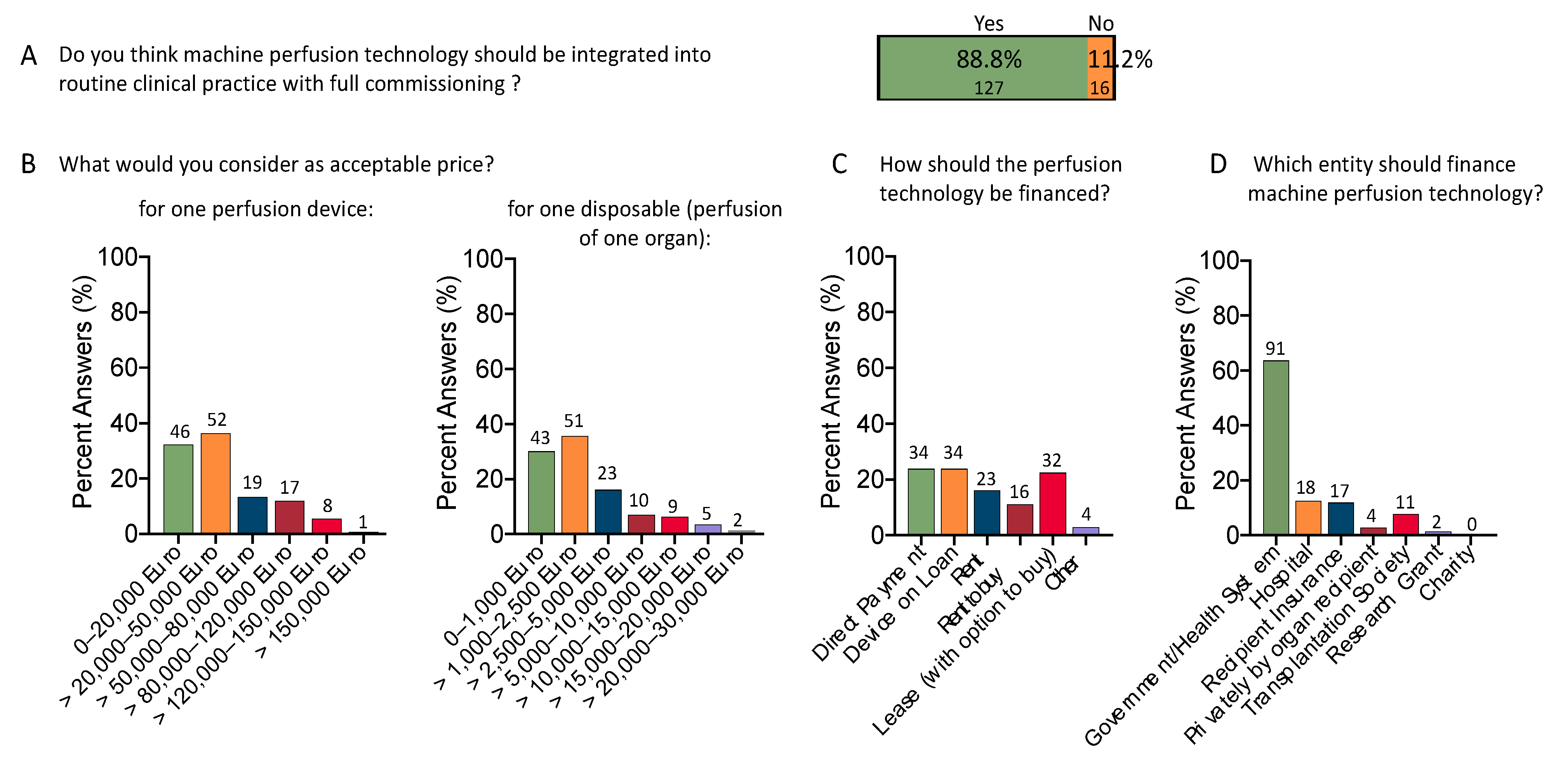
| Parameter | Characteristics | Parameter | Characteristics | ||
|---|---|---|---|---|---|
| Employment Position | Department Head: Consultant: Registrar: Fellow: Nurse: Other (Industry, coordinator): | 30.1% (n = 43) 41.3% (n = 59) 5.6% (n = 8) 5.6% (n = 8) 7.7% (n = 11) 9.8% (n = 14) | Number of Transplant Procedures annually per center | >300: 201–300: 151–200: 101–150: 51–100: 21–50: 0– 20: n.a. | 7.0% (n = 10) 14.7% (n = 21) 12.6% (n = 18) 13.3% (n = 19) 32.2% (n = 46) 10.5% (n = 15) 4.9% (n = 7) 4.9% (n = 7) |
| Working Role | Transplant Surgeon: Physician: Transplant coordinator: Intensive Care Nurse: Anesthetist/Intensivist: Theatre Nurse: Other (Industry): | 64.3% (n = 92) 15.4% (n = 22) 4.9% (n = 7) 3.5% (n = 5) 1.4% (n = 2) 1.4% (n = 2) 9.1% (n = 13) | DCD transplant program | Yes No Not applicable § | 65.0% (n = 93) 28.7% (n = 41) 6.3% (n = 9) |
| Gender | Female: Male: | 32.2% (n = 46) 67.8% (n = 97) | Declined livers annually * | > 30% 21–30% 11–20% 6–10% 0–5% Don’t know | 8.8% (n = 11) 16.0% (n = 20) 32.0% (n = 40) 28.0% (n = 35) 8.0% (n = 10) 7.2% (n = 9) |
| Age | 36–45 years: 46–55 years: 56–65 years: 26–35 years: >65 years: | 44.1% (n = 63) 23.1% (n = 33) 16.1% (n = 23) 12.6% (n = 18) 4.2% (n = 6) | Region | Europe: USA: Other (e.g., Central and South America, Asia, Australia) | 64.3% (n = 92) 10.5% (n = 15) 25.2% (n = 36) |
| Working Experience (years) | >20 years: >10–20 years: >5–10 years: >2–5 years: | 35.7% (n = 51) 33.6% (n = 48) 21.7% (n = 31) 9.1% (n = 13) | Hospital type and Working environment | University Hospital: City/Regional Hospital: Covering regions and industry: Other types of Hospital: | 67.9% (n = 97) 16.8% (n = 24) 6.3% (n = 9) 2.8% (n = 4) |
| Device Name | Company and Country of Production | Perfusion Modality | Organs | First Clinical Use | Leading Countries of Use | Disposable Costs | Achieved Approvals | Ongoing Prospective Trials and RCTs |
|---|---|---|---|---|---|---|---|---|
| Metra® | Organox, United Kingdom | Normothermic Machine Perfusion | Liver | 2013, UK | UK, Austria, Germany | $$$ | CE mark, FDA approved | USA, Germany, Spain |
| OCSTM liver® | Transmedics, USA | Normothermic Machine Perfusion | Liver | 2016, UK and USA | USA | $$$$ | CE mark, FDA approved | None |
| Liver Assist® | XVIVO (Organ Assist), Sweden (The Netherlands) | Normothermic and Hypothermic Oxygenated Perfusion | Liver | 2012, Switzerland | The Netherlands, Belgium, Italy, France, Sweden | $–$$ | CE mark | France, Netherlands, Poland, Germany |
| PerLife® | Aferetica, Italy | Normothermic and Hypothermic Oxygenated Perfusion | Liver, kidney | 2021, Italy | Italy | $$ | CE mark | Italy, Germany |
| Lifeport liver transporter® | Organ Recovery Systems, USA | Hypothermic Machine Perfusion | Liver | 2019, USA | USA | $$ | FDA approval expected in 2023 | USA |
| VitaSmart® | Bridge to life, USA/Europe (production: Medica, Italy) | Hypothermic Oxygenated Perfusion | Liver, kidney | 2018, Italy | Switzerland, Portugal, Sweden, India, UK, France | $–$$ | CE mark, ongoing RCT for FDA approval | USA, France, Germany, Italy |
Disclaimer/Publisher’s Note: The statements, opinions and data contained in all publications are solely those of the individual author(s) and contributor(s) and not of MDPI and/or the editor(s). MDPI and/or the editor(s) disclaim responsibility for any injury to people or property resulting from any ideas, methods, instructions or products referred to in the content. |
© 2023 by the authors. Licensee MDPI, Basel, Switzerland. This article is an open access article distributed under the terms and conditions of the Creative Commons Attribution (CC BY) license (https://creativecommons.org/licenses/by/4.0/).
Share and Cite
Parente, A.; Flores Carvalho, M.; Panconesi, R.; Boteon, Y.L.; De Carlis, R.; Dutkowski, P.; Muiesan, P.; Dondossola, D.; Schlegel, A. Trends and Obstacles to Implement Dynamic Perfusion Concepts for Clinical Liver Transplantation: Results from a Global Web-Based Survey. J. Clin. Med. 2023, 12, 3765. https://doi.org/10.3390/jcm12113765
Parente A, Flores Carvalho M, Panconesi R, Boteon YL, De Carlis R, Dutkowski P, Muiesan P, Dondossola D, Schlegel A. Trends and Obstacles to Implement Dynamic Perfusion Concepts for Clinical Liver Transplantation: Results from a Global Web-Based Survey. Journal of Clinical Medicine. 2023; 12(11):3765. https://doi.org/10.3390/jcm12113765
Chicago/Turabian StyleParente, Alessandro, Mauricio Flores Carvalho, Rebecca Panconesi, Yuri L. Boteon, Riccardo De Carlis, Philipp Dutkowski, Paolo Muiesan, Daniele Dondossola, and Andrea Schlegel. 2023. "Trends and Obstacles to Implement Dynamic Perfusion Concepts for Clinical Liver Transplantation: Results from a Global Web-Based Survey" Journal of Clinical Medicine 12, no. 11: 3765. https://doi.org/10.3390/jcm12113765
APA StyleParente, A., Flores Carvalho, M., Panconesi, R., Boteon, Y. L., De Carlis, R., Dutkowski, P., Muiesan, P., Dondossola, D., & Schlegel, A. (2023). Trends and Obstacles to Implement Dynamic Perfusion Concepts for Clinical Liver Transplantation: Results from a Global Web-Based Survey. Journal of Clinical Medicine, 12(11), 3765. https://doi.org/10.3390/jcm12113765







